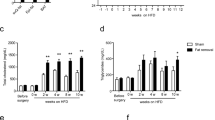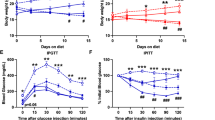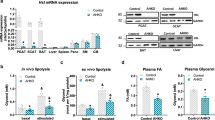Abstract
Lipoatrophic (lipodystrophic) diabetes is a disorder in which insulin resistance and hyperglycaemia are associated with a reduced body-fat mass1, in contrast to the usual association of diabetes with obesity. Transgenic mice with differing degrees of fat loss can be used as models for lipoatrophy2,3,4. Using the aP2-SREBP-1c mouse3, which has a moderate fat deficiency, Shimomura et al. showed that leptin treatment reverses the diabetes, concluding that insulin resistance in congenital generalized lipodystrophy can be explained by a leptin deficiency5. However, we have used a more severe model of lipoatrophy, the A-ZIP/F-1 mouse2,6, in which we find that leptin treatment is only slightly effective in correcting diabetes.
Similar content being viewed by others
Main
A-ZIP/F-1 mice (Table 1) have an almost complete lack of white adipose (fat) tissue, a severe resistance to insulin, diabetes, and greatly reduced serum leptin levels2. We found that infusing leptin into A-ZIP/F-1 mice at the same rate (5 μg day−1 for 4 weeks, starting at 7 weeks of age) and to produce the same serum leptin level (3 ng ml−1) as in Shimomura et al.'s mice had no effect on serum glucose or insulin concentrations (results not shown). A higher leptin dose (30 μg per day, causing leptin to rise by 5 ng ml−1) did reduce glucose and insulin levels (Fig. 1), food intake (from 6.6±0.3 to 4.7±0.2 g day−1, P<0.001), and liver weight (from 3.04±0.04 to 2.09±0.11 g, P<0.001). Even at this higher dose, however, our mice still had markedly raised blood glucose and insulin levels.
Leptin (R&D Systems) was infused into male mice by using an osmotic pump (Alzet) at 30 μg day−1 for six days, ending at 7 or 13 weeks of age, as indicated. Data are mean and s.e.m. with n = 6/group; single and double asterisks indicate differences between treated and control at P ≤ 0.01 and P < 0.001, respectively. Non-fasting glucose was measured using a Glucometer Elite (Bayer) and insulin was quantified by radioimmunoassay (Linco).
In our A-ZIP/F-1 mice, the efficacy of leptin treatment diminished with age: at 13 weeks (the age of Shimomura et al.'s mice), leptin had a minimal effect (Fig. 1), and no effect at all at 28 weeks (results not shown). In contrast, leptin infusion into 13-week-old leptin-deficient ob/ob mice completely normalized both glucose and insulin levels (Fig. 1).
Evidence from humans and mice supports the conclusion that leptin deficiency cannot completely explain the diabetic phenotype of generalized lipoatrophy. Patients with generalized lipoatrophy are more prone to diabetes1 than are those who lack leptin7,8,9; similarly, A-ZIP/F-1 mice are more diabetic than ob/ob mice (Fig. 1). Thus leptin deficiency contributes to the insulin resistance of generalized lipoatrophy, but is neither the sole nor the principal cause of insulin resistance in severe forms of this disease.
The observed differences between the A-ZIP/F-1 and aP2-SREBP-1c mice are probably due to their different amounts of fat, although transgene-specific effects or their different genetic backgrounds may play a part. aP2-SREBP-1c mice have more residual adipose tissue: in these mice, leptin appears to be limiting and its replacement reverses their diabetes. A-ZIP/F-1 mice must experience loss of other functions provided by adipose tissue besides leptin secretion — for example, functions that affect fatty-acid and triglyceride metabolism. Alternatively, adipose tissue might exert a direct or indirect endocrine effect.
References
Foster, D. W. in Harrison's Principles of Internal Medicine (eds Isselbacher, K. J. et al.) 2131–2136 (McGraw-Hill, New York, 1994).
Moitra, J. et al. Genes Dev. 12, 3168–3181 (1998).
Shimomura, I. et al. Genes Dev. 12, 3182–3194 (1998).
Burant, C. F. et al. J. Clin. Invest. 100, 2900–2908 (1997).
Shimomura, I., Hammer, R. E., Ikemoto, S., Brown, M. S. & Goldstein, J. L. Nature 401, 73–76 (1999).
Gavrilova, O. et al. Proc. Natl Acad. Sci. USA 96, 14623–14628 (1999).
Montague, C. T. et al. Nature 387, 903–908 (1997).
Strobel, A., Issad, T., Camoin, L., Ozata, M. & Strosberg, A. D. Nature Genet. 18, 213–215 (1998).
Farooqi, I. S. et al. N. Engl. J. Med. 341, 879–884 (1999).
Author information
Authors and Affiliations
Corresponding author
Rights and permissions
About this article
Cite this article
Gavrilova, O., Marcus-Samuels, B., Leon, L. et al. Leptin and diabetes in lipoatrophic mice. Nature 403, 850 (2000). https://doi.org/10.1038/35002663
Issue Date:
DOI: https://doi.org/10.1038/35002663
This article is cited by
-
The role of leptin in diabetes: metabolic effects
Diabetologia (2016)
-
Lessons for human diabetes from experimental mouse models
Current Diabetes Reports (2003)
-
Triglycerides and toggling the tummy
Nature Genetics (2000)
-
Mouse models of lipodystrophy
Current Atherosclerosis Reports (2000)
Comments
By submitting a comment you agree to abide by our Terms and Community Guidelines. If you find something abusive or that does not comply with our terms or guidelines please flag it as inappropriate.




